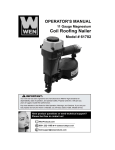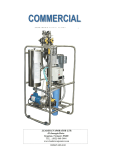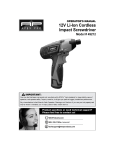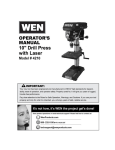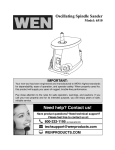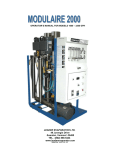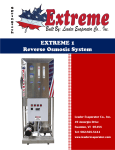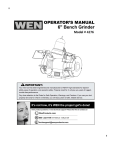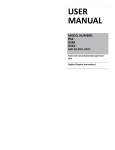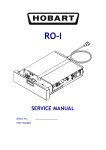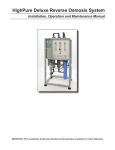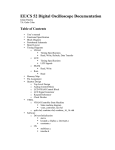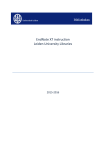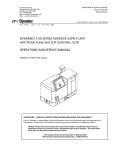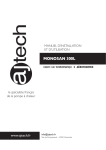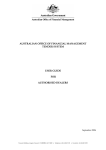Download LEADER EVAPORATOR LTD. 49 Jonergin Drive Swanton, Vermont
Transcript
OPERATOR’S MANUAL FOR 50 GPH MODEL LEADER EVAPORATOR LTD. 49 Jonergin Drive Swanton, Vermont 05488 TEL. : (802) 868-5444 VERSION : 25 JAN. 2006 www.leaderevaporator.com OPERATOR’S MANUAL FOR MICRO OSMOSIS TABLE OF CONTENTS___________________________ 1. MODE D’EMPLOI DE CONCENTRATEUR MICRO ............................ 5 1.1 INTRODUCTION ....................................................................................... 5 1.2 BACKGROUND.......................................................................................... 5 1.3 OPERATION ............................................................................................... 5 1.4 INSTALLATION....................................................................................... 12 2. YEARLY START UP................................................................................... 14 3. USER’S GUIDE ............................................................................................ 15 3.1 MEMBRANE PERMEABILITY TEST ................................................. 16 3.2 ANNUAL CLOSING PROCEDURE ...................................................... 19 4. MANUFACTURER WARRANTY ............................................................ 20 5. EQUIPMENT DESCRIPTION................................................................... 19 5.1 PHYSICAL DIMENSIONS...................................................................... 19 5.2 FRONT PANEL......................................................................................... 22 5.3 ELECTRICAL BOX ................................................................................. 23 5.4 OPERATION DATA................................................................................. 24 WASHING AND TAKING CARE OF MEMBRANES ............................... 28 2 LIST OF FIGURES__________________________ FIGURE 1. OSMOSIS AND REVERSE OSMOSIS ........................................................... 4 FIGURE 2. FUNCTIONING (MICRO OSMOSIS 50 GPH).............................................. 6 FIGURE 3. THERMOSTAT ......................................................................................... 7 FIGURE 4. PRE FILTER ............................................................................................ 7 FIGURE 5. LOW PRESSURE SWITCH .......................................................................... 8 FIGURE 6. PRESSURE GAUGES ................................................................................. 8 FIGURE 7. PRESSURE PUMP ..................................................................................... 9 FIGURE 8. MEMBRANE .......................................................................................... 10 FIGURE 9. INSTALLATION GUIDE ........................................................................... 12 FIGURE 10. PICTOGRAM ........................................................................................ 17 FIGURE 11. REVERSE OSMOSIS UNIT ..................................................................... 21 FIGURE 12. FRONT PANEL ..................................................................................... 22 FIGURE 13. ELECTRICAL CONTROL BOX FOR 50 GPH........................................... 23 FIGURE 14. OPERATION DATA ............................................................................... 24 FIGURE 15.PRODUCTION SHEET FOR REVERSE OSMOSIS ...................................... 26 FIGURE 16. CORRECTION FACTOR SHEET ............................................................. 28 3 Figure 1. Osmosis and reverse osmosis 4 1. MODULAIRE MICRO-OSMOSIS USER’S MANUEL CONGRATULATIONS! You just acquired an LEADER EVAPORATOR reverse osmosis. This proves your interest in new technologies and beautiful things. In fact, you have purchased a technologically advanced unit built by skilled professionals at A. Pellerin & Fils Ltée, who bring many years of research to the use of reverse osmosis in maple syrup production. 1.1 INTRODUCTION Reverse osmosis is a process by which a solution’s natural tendency to scatter its components uniformly is reversed. It occurs in the reverse osmosis because an applied pressure forces the water through a semi-permeable membrane. The water that does not pass through the membrane is left with all the sugar and thus called the concentrate. 1.2 BACKGROUND The reverse osmosis process has been observed and studied for more than 250 years. Father Nolet, a French scientist, carried out experiments on the osmosis phenomenon around 1748. The scientists realized long ago that this process could be reversed and that many applications could flow from this research. The principle of reverse osmosis has been applied to the desalination of water since the beginning of 1960. 1.3 OPERATION How does it work? This is probably the first question that came to your mind as you opened this manual. The sap provided by maple trees is a solution containing mostly water (96% to 98%), 2% to 3% sugar and small quantities of mineral salts, proteins and other elements such as aroma. Sap is the solution in which you will increase the amount of sugar in relation to the quantity of water. This will be done by extracting the water from the maple tree sap. This separation process will give a more concentrated sap solution (concentrate) and the portion of water, which has been subtracted from the sap (permeate). 5 FLOWCHART MICRO-OSMOSIS OUTPUT Thermostat To permeate basin T Permeate Flowmeter T Output PUMP MEMBRANE Valve V18 Input Wash P Pump pressure Membrane Pressure Filtre Figure 2. Functioning (micro osmosis 50 GPH) Sap and permeate basins The sap basin contains the maple tree sap. The permeate basin is filled with the water extracted from the sap during the concentration procedure. We recommend that the sap and permeate basins be connected with a common feeding pipe. We also recommend that the permeate basin be able to contain at least twice the unit’s capacity. IT IS PREFERABLE TO PLACE THE MAPLE SA P, EVAP ORATOR AN D PER MEATE BASIN S IN SUCH A WAY THAT GRAVITY WILL CAUSE THE LIQUIDS TO RUN. Sap and permeate pipes A return permeate line is already installed, this line must be installed up to the permeate basin. THE EVAPORATOR MUST BE INSTAL LED AT LOWE R LEVEL IN SUCH A W AY THAT GRAVITY WILL CAU SE THE LI QUIDS TO RUN. Sap, permeate, drain and evaporator basin valves Please note that the sap and permeate basins are not supplied by the company. You must provided the valves and pipes that will be installed at the output of your permeate and sap basin respectively, the flow of those basins must be controlled by a valve located under each one. Also at the evaporator input and for the drain valve. 6 Thermostat This controller evaluates the liquid’s temperature as it penetrates the reverse osmosis. The value is immediately displayed on a screen located on the reading panel. The temperature must never exceed 49o Celsius (120o Fahrenheit). The programming procedure of this thermostat is explained in the following way : No. ITEM 1 No. SQUAD Quantity Description 01152443 1 JOHNSON CONTROL VACUUM PUMP THERMOSTAT (DIGITAL) 174087 4 ROUNDED HEAD ROBERTSON SCREW 6-32 X 1/2'' 108006 4 LOCKNUT 6-32 Figure 3. Thermostat Pre-filter The sap is filtered by a 10 microns cartridge. This clears it from any substance in suspension. . Figure 4. Pre filter No. Item 2 3 4 5 6 7 8 9 No. Squad 04211138 04213457 04213294 PI450822S 04210250 04210226 5000309 04211010 Quantity 1 2 2 2 1 1 4 1 Description SEDIMENT POT FILTER 10'' STAINLESS 316 ELBOW, 150 PSI 1/4" NIPPLE STAINLESS 316 SCH40 3/4’’ X 1’’ (CLOSED) FITTING PUSH-IN 1/4'' OD TUBE X 1/4’’ NPTF PVC ELBOW 90 DEGREE 3/4'' MPT X 3/4’’ INS PVC ADAPTER 3/4‘’ MPT * 3/4'' INS HEXAGONAL STAINLESS BOLT 1/4-20 * 1’’ PREFILTER CARTRIDGE 10 MICRONS 9 7/8’’ 7 Low Pressure control This control ensures that dirt or micro-organisms do not obstruct the filters. If such were the case, the machine would stop by itself, thus protecting the pumps and membranes. Figure 5. Low pressure switch No. ITEM No. SQUAD Quantity Description 10 01150143 1 LOW PRESSURE CONTROL P10-BC7C 11 01260746 1 LOW PRESSURE MOUNTING FOR R/O 1-13/16'' .010 12 01280430 1 PVC ADAPTER FOR PRESSURE SWITCH FOR R/O 13 5105093 4 SLOTTED MECHANICAL SCREW SS 6-32 X 1-1/4'' Pressure gauge (pump pressure) 0-300 PSI This gauge allows you to read the pressure output, its value is indicated on the reading panel. Figure 6. Pressure gauges No. ITEM 36 No. SQUAD 01090021 Quantity 2 Description GAUGE 0-300 PSI GLYCERIN BACK CONNECTION Pressure gauge (membrane pressure) 0-300 PSI This gauge allows you to read the pressure at the membrane. This gauge is located at the front panel which allows you to read the pressure in PSI or KPa. If this pressure should drop below 12 psi (82,737kPa), the machine will stop by itself. 8 Pressure pump (4) The filtered water is pressurized with the help of the pressure pump. This gives the sap the necessary speed to clean the membrane surface automatically during the sap concentration process. The same thing happens to the washing liquid during the soap and recirculation washes. # ITEM 14 15 16 17 18 19 20 21 22 23 24 25 26 No. SQUAD 96080242 04212065 01261143 01171145 01154156 01151157 04213457 04210250 01261142 AC13HH-440 4OMPU40 Quantity 1 1 1 1 1 2 2 1 1 1 1 1 1 Description GRUNDFOS PUMP 10SQ10C-330 1C HP/240V 3’’DIA. 1-1/4 STAINLESS REDUCER 1 1/4’’ MPT* 3/4’’ FPT ÈNVELOPE COVER FOR PUMP 3 1/2‘’ ADAPTER SS 1/4’’ COMPRESSION X 1/4’’ MPT ELEC. NYLON CONNECTOR 1/2’’ NPT REMKE GREY BUSHING 3 HOLES FOR CONNECTOR 01154156 .156’’ STAINLESS 316 ELBOW 150 PSI 1/4'' PVC ELBOW 90 DEGREE 3/4'' MPT X 3/4’’ INS PUMP ENVELOPE 3 1/2’’ FOR MICRO OSMOSIS MAPLE GROVE LIQUID INLET LIQUID OUTLET HEAVY DUTY CLAMP SINGLE PIN 4’’ STANDARD CLAMB GASKET BUNA-N 4’’ Figure 7. Pressure pump 9 Membrane The sap is concentrated by the membranes resulting in a sweeter sap (concentrate) and treated water (permeate). No. ITEM No. SQUAD Quantity 27 01260004 1 Description MEMBRANE 4'' X 40'' HYDRANAUTICS PVD1 28 01260449 1 ADAPTER 4'' HYDRANAUTICS VS AIRABLO (0,800-0, 0.750) 29 01260787 1 PLUG 4'' HYDRANAUTICS VS AIRABLO 5 30 01300066 2 O-RING 13/16'' ID 1'' OD 3/32'' MUR 31 01300135 2 O-RING 3/4'' ID 1'' OD 1/8'' MUR 32 01300574 1 O-RING 3 1/4'' ID 3 3/4'' OD 1/4'' WALL BANJO FILTER 33 01300576 1 O-RING 3 1/2'' ID 4'' OD 1/4'' MUR (COUVERCLE 4'') 51 PI091624S 1 ELBOW PUSH-IN 1/2’’ TUBE X 1/2’’ MALE NPT 52 04210352 1 PVC ELBOW 90 3/4’’ INS * 3/4’’ FPT 0 53 04213459 1 STAINLESS 316 ELBOW 150PSI 1/2’’ 54 AC13HH-440 2 HEAVY DUTY CLAMP SINGLE PIN 4’’ (WITH ITEM 40MPU40) 55 04210225 1 PVC ADAPTER 1/2’’ MPT *1/2’’ INS 56 01040846 1 BALL VALVE 1/2’’ SS 2000 PSI NEW 57 04211603 1 ELBOW STAINLESS 90 DEGREE 1/2’’ MPT * 1/2’’ FPT 58 04213579 1 T STAINLESS 316 150 PSI 1/2’’ FPT 59 04213423 1 STAINLESS 316 REDUCER 150 PSI 1/2’’ MPT * 1/4’’ FPT 60 01172298 20’ 61 01172296 1 62 04211797 2 NIPPLE STAINLESS 1/2’’ MPT * CLOSE 63 04211015 1 CLIP 1/2” A 1” HF-8 PIPE SS 5/16’’ OD #304 .035’’ WALL 20’ ADAPTER SS 5/16’’ COMPRESSION * 1/4’’ MPT Figure 8. Membrane 10 Permeate flowmeter As it comes out of the membrane, the permeate is run directly through this flowmeter. The flow value is indicated on the reading panel in GPM. During the concentration process, the liquid is directed to the permeate storage basin. It is essential to know the permeate and concentrate flows. VALVE V18 : This valve is closed during the concentration process. It is open while washing or rinsing. CONCENTRATION FU NCTIONING: Place the switch in CONCENTRATION mode and the selector in ON position and push the start button until the membrane pressure surpasses 20 PSI. PLEASE NOTE THAT: the manufacturer does not include the following valves: • Osmosis inlet valve • Osmosis outlet valve • Evaporator valve • Bypass valve • Permeate and sap valves • Drain valve STOP: The unit will stops when you select the SELECTOR OFF operation mode. WASHING FUNCTIONING: Place the switch in WASH mode, the selector in ON position and push the start button until the membrane pressure surpasses 20 PSI. 11 1.4 INSTALLATION The micro osmosis ‘’LEADER EVAPORATOR’’ is delivered without permeate and sap basins. You must connect the pipes and valves that will be connected at the sap and permeate basins. (see the diagrams on user’s guide). The pipe diameter has to be equal to or greater than that of the filter installed on the machine. You must plan your connecting pipes to prevent restriction during the rinse and concentration cycles. Watertightness of the feeding pipe must be checked to prevent vibrations which could cause pressure pump and membrane deterioration. This is one suggestion for the unit’s installation in concentration mode. CONCENTRATION PERMEATE SAP RESERVOIR Permeate flowmeter Sap Valve Permeate Valve Evaporator Evaporator Valve Outlet osmosis valve OUTPUT PUMP Inlet osmosis valve Bypass Valve Drain Valve (close) MEMBRANE PERMEATE RESERVOIR Valve V18 OUTPUT INPUT GREEN LINE = OPEN RED LINE = CLOSE Figure 9. Installation guide Sap and permeate basins The sap basin contains the maple tree sap. The permeate basin is filled with the water extracted from the sap during the concentration procedure. We recommend that the sap and permeate basins be connected with a common feeding pipe. We also recommend that the permeate basin be able to contain at least twice the unit’s capacity. IT IS PREFE RABLE T O PLACE T HE MAPLE SAP AN D PERMEAT E BASINS IN SUCH A WAY THAT GRAVITY WILL CAUSE THE LIQUIDS TO RUN. 12 A well lit, well heated, well ventilated, isolated shelter for the machine should be planned in the saphouse. The entrance door dimensions must be calculated according to the machine dimensions (see section 5.1). The shelter should be heated prior to delivery and installation of the machine. The durability of the electrical components will depend on the feeding quality. Therefore, it is very important to have your electrician check your installations to make sure that they comply with the local electricity code standards. 13 2. YEARLY START UP All the following procedures can be made with spring water (without Chlorine!) or well water, as long as it is clean and does not stain. Your machine has been filled with a glycol solution to prevent the membranes and other components from freezing. The preparation of your system at the beginning of each season must be carried out in the following way: ¾ Read the user’s manual completely. ¾ Call an electrician to connect the unit to an electrical source. ¾ Connect the unit to the maple sap, concentrate and permeate basins. ¾ Connect the permeate pipe beneath the membrane. ¾ Plug in the machine and rinse the unit following the same process as for membrane rinsing with half the number of water gallons your unit can concentrate in an hour. For example, if your machine has an 8 inches membrane, thus a 600 gallons per hour (GPH) capacity, rinse it with 300 gallons of water. ¾ Perform a washing without soap, reaching a water temperature of 460C (1150F). ¾ Do a second rinsing cycle as soon as the washing cycle is finished. ¾ Do a second washing without soap. It is very important to reach the water temperature mentioned before. ¾ Do another rinsing cycle as soon as the washing cycle is finished. ¾ Do a third washing cycle, this time adding the soap. Make sure to reach a temperature of 460C (1150F). ¾ Do a final rinsing cycle with half the number of water gallons your unit can concentrate in an hour. ¾ Carry out a permeability test of membranes 1. Put 10 gallons (approximately) of water in the sap reservoir. 2. Concentrate the permeate at 100 PSI pressure. Returning the permeate and concentrate to the sap basin. To do that, you must position the valves and pipes in washing soap cycle, adjust the pressure to 100 PSI by closing the valve V18. 3. Take down a reading of permeate flow when the temperature reaches 210C (700F). This reading will indicate you the filtration capacity of your membrane only without imply another factor such as temperature, biofilms or bacteria. You can compare the permeate flow value with the one taken when the unit was manufactured. 4. Compare the permeate flow value with the one taken when the unit was manufactured or after you first utilisation during the season. You will evaluate in this way the permeability of your membrane. This data will be your reference for other successive tests. You are now ready to concentrate maple sap. 14 3. USER’S GUIDE This manual was designed to help you work with your reverse osmosis. All of these instructions are also printed on the front of your machine. (see the following pictograms). 15 16 Figure 10. Pictogram 17 3.3 MEMBRANES PERMEABILITY TEST IT IS VERY IMPORTANT THAT YOU REMEMBER TO TAKE THIS DATA EVERY DAY YOU USE YOUR REVERSE OSMOSIS. THIS WILL ENABLE YOU TO DETECT ANY OPERATIONAL DIFFICULTY. The filtration process and the membrane’s performance vary depending on the type of membrane, exerted pressure on membrane, sap temperature, percentage of sugar in the concentrate, and presence of other components such as bacteria, biofilm and mineral salts. Therefore, it is important to maintain similar test conditions for all samplings. To do so, we recommend that you use the following method: 1. Prepare a basin full of permeate obtained from sap concentration or from clear, detritus free spring water. 2. Rinse machine for 10 minutes with permeate so that only permeate remains inside. 3. Put 10 gallons (approximately) of water in the sap reservoir. 4. Concentrate the permeate at 100 PSI pressure. Returning the permeate and concentrate to the sap basin. To do that, you must position the valves and pipes in washing soap cycle, adjust the pressure to 100 PSI by closing the valve V18. 5. Take down a reading of permeate flow when the temperature reaches 210C (700F). This reading will indicate you the filtration capacity of your membrane only without imply another factor such as temperature, biofilms or bacteria. You can compare the permeate flow value with the one taken when the unit was manufactured. 6. Compare the permeate flow value from your test (no 5) to the same test made at the factory or when you operated your machine for the first time during the season. You will then be able to establish the exact condition of your membrane. 18 3.4 ANNUAL CLOSING PROCESS All of the following procedures can be made with spring water (without Chlorine!) or well water, as long as it is clean and does not stain. Use as much p ermeate water as possible to store your machine. 1 Rinse your machine with half the number of water gallons it can concentrate per hour. 2 Wash the machine with the amount of soap recommended and let the temperature raise up to 460C (1150F). Soap = 4 ounces per membrane. 3 Rinse your machine with half the number of water gallons it can concentrate per hour. 4 Wash the machine with ACID and let the temperature raise up to 460C (1150F). The unit should soak as long as possible (maximum 1 month). 5, 6, and 7 Do another rinse and wash soap cycle followed by another rinsing as you had done in the three first steps. Do a permeability membrane test. ¾ Put 10 gallons (approximately) of water in the sap reservoir. ¾ Concentrate the permeate at 100 PSI pressure. Returning the permeate and concentrate to the sap basin. To do that, you must position the valves and pipes in washing soap cycle, adjust the pressure to 100 PSI by closing the valve V18. ¾ Take down a reading of permeate flow when the temperature reaches 210C (700F). This reading will indicate you the filtration capacity of your membrane only without imply another factor such as temperature, biofilms or bacteria. You can compare the permeate flow value with the one taken when the unit was manufactured. ¾ Compare the permeate flow value with the one taken when the unit was manufactured or after you first utilisation during the season. You will evaluate in this way the permeability of your membrane. This data will be your reference for other successive tests. 8 If your membrane is clean, continue on step # 9. If you are not satisfied with the cleanness of your membrane, you can pursue this process on step # 4 or simply send back the membrane to be CLEANED at the factory. 9 Put 20 litres of permeate in the washing basin and 4 litres of glycol or glycerine. Add a teaspoon of preserve-osmo and let the water flow for 15 minutes. Then, stop your machine and HEAT the room all year between 50C and 100C. P.S.: If the room is subject to FREEZING, put 10 litres of glycol or glycerine for each 4’’ x 40’’ membrane, 20 litres for each 8’’x 40’’ membrane and 30 litres for each 8’’x 60’’ membrane in the wash basin and let the liquid run inside the machine (see annual storage with antifreeze). 19 4. MANUFACTURER WARRANTY Reverse osmosis LEADER EVAPORATOR machines are guaranteed by their manufacturer against all workmanship defects for a period of two complete seasons, starting on the installation date of the machine. The manufacturer’s responsibility regarding this warranty is limited to the repair or replacement of parts when he should consider it necessary to do so. All replaced parts become the manufacturer’s property. A. Pellerin & Fils Ltée shall not be held responsible for any damage or injury arising from negligence, abuse, improper handling or installation. 20 5. EQUIPEMENT DESCRIPTION 5.1 PHYSICAL DIMENSIONS FOR (50 GAL) UNIT Height: 52" Width: 18" Depth: 25" 52" 18" 25" Figure 11. Reverse osmosis unit 21 5.5 FRONT PANEL The reading panels were designed to meet your needs. They include the following items as standard equipment No. ITEM 34 35 36 37 38 39 10 41 42 43 44 45 46 47 48 49 50 No. SQUAD 01154173 01152443 01090021 01260893 RB233 01152476 01150143 01090025 04213577 04213457 PI010822S PE08BI0500F-W 01301392 04210350 408005 PI011604S 04210581 Quantity 1 1 2 1 1 1,5 1 2 1 1 2 2 1 1 1 1 15 Description CONTROL BOX FOR MICRO OSMOSIS 1 HP 240V JOHNSON CONTROL VACUUM PUMP THERMOSTAT DIGITAL GAUGE 0-300 PSI GLYCERIN BACK CONNECTION NO VALVE FLOWMETER 2 GPM 5’’ PVC ADAPTER RONDELLE ISOLANTE CAOUT. 7/16’’ ID 15/16’’ OD 7/16’’ ELECTRICAL WIRE 18/6 SOW (PRICE BY FOOT) LOW PRESSURE SWITCH P10-BC7C GAUGE BACK HOLDER 2 1/2’’ T STAINLESS 316 150PSI 1/4’’ FPT STAINLESS 316 ELBOW 150 PSI ¼’’ FITTING PUSH-IN 1/4’’ HOSE X 1/4’’ MALE NPTF TUBE PUSH – IN 1/4’’ OD WHITE FDA 120 PSI AT 150 F POLYETHYLENE PNUMATIC TUBE 1/2 OD NATURAL 100’ 0 PVC ELBOW 90 1/2’’ INS * 1/2’’ FPT 0 PVC ELBOW 90 1/2’’ FPT ADAPTER PUSH-IN 1/2’’ TUBE X 1/2’’ MALE NPT TUBE PVC 1/2"I.D. 200PSI(70F)-100PSI(122F) 300' Figure 12. Front panel 22 5.6 ELECTRICAL BOX 8 10 No. ITEM 1 No. SQUAD 01150964 Quantity 1 Description PVC BOX LUME 9 X 7 X 6.5 (220 X 170 X 150) 2 01151650 1 BACKPLATE FOR VACCUM AND WASHER 3 01150758 1 ELECTRICITY 2 METERS DIN RAIL 1 1/4" 4 01150757 1 ALUMINUM GROUND BAR 6' - 0 5 01151588 1 SCREW STRIP 300V 8 TERMINALS 4.25" LONG 6 01150727 1 MAGNETIC DP25-3 208-230 V/ 60 HZ. 7 01150625 1 OVERLOAD 8 AMP. TO 12 AMP. (TYPE TI 16C, TI 25C) 8 01153334 1 FLUSH PUSH BUTTON SPRING RETURN DANFOSS GREEN 9 01153379 1 CONTACT BLOCK 2 POSITION CONTACT NO+NO 10 01153351 1 SELECT SWITCH 2 POS. STAYPUT STANDARD HANDLE 11 01153684 1 TOGGLE SWITCHES 5 AMP 250VAC BLACK PLASTIC 2 WIR 12 01153200 2 LOG SLU 25S 13 01152325 1 MALE CARD 3 LEGS 15A, 250V LEV 615 PA EAG ,4866 14 01150985 15 15 FEETS WIRE 14/3 SJOOW (PRICE/FOOT) Figure 13. Electrical control box for 50 GPH 23 5.7 OPERATION DATA Your machine operation data has to be taken on every day of use. These readings are essential to insure an efficient maintenance of your membranes. They also help you detect operating problems immediately. The readings have to be taken half an hour after the beginning of the concentration cycle. Write down your observations in the following tables : 1) Date: date of the day you collect the data. 2) Sap density: in Brix degrees. 3) Permeate flow: measured by the permeate flowmeter. 4) Water temperature: for the water that is treated inside the reverse osmosis.. 5) Membrane pressure: measured by the membrane pressure gauge. Density (Brix) 12 6 june 02 6 june 02 6 june 02 Sap 2.0 Flow (GPM) Temperature Permeate 3 7.5 7.5 Degrees F. 4 55 55 Pressure PSI 5 200 400 Or Test T C Figure 14. Operation data 24 Density (Brix) 1 Sap 2 Flow (GPM) Temperature Permeate 3 Degrees F. 4 Pressure PSI 5 25 Figure 15.Production sheet for reverse osmosis CONCENTRATOR : MEMBRANE MODELS SERIAL No. : Serial No._______________ 1._____________________ 1.______________________ Model __________________ 2._____________________ 2.______________________ Pump __________________ 3._____________________ 3.______________________ Motor____________________ 4._____________________ 4.______________________ HP MODÈL Pumps Serial Pump # Motor serial # PRIMING PRESSURE # 1 PRESSURE #2 PRESSURE #3 PRESSURE #4 ACID AL KALIN SOAPS OXYD ANTS Hydranautic PVD1 4 oz Acid-Osmo 4 oz Sani-Osmo Filmtec NF70-BW30 4 oz Acid-Osmo 4 oz Sani-membrane 4 oz Oxy-membrane Fluid System TFC 4 oz Acid-Osmo 4 oz Sani-membrane 4 oz Oxy-membrane CONDUCTIVITY TEST Membrane Conductivity Temperature FLOW PRESSURE No. Concentrate o Permeate F Permeate Concentrate PSI 1 2 3 4 TEMPERATURE CONTROL Temperature 480C (1180F) ELECTRICAL TESTS Test dielectric _________________OK Total Amperage : _______________Amps. PROTECTION AGAINTS FREEZE Density :_________________ Temperature :__________ Buyer’s Name :___________________ Salesman Name :__________________________ Order # :__________________ Technicien:_______________________________ Date________________________________ 26 Fill up in case of malfunction Our goal is to offer you an impeccable product. This is why every REVERSE OSMOSIS machine is thoroughly inspected at the factory. We ask that you help us improve our production methods by sending your comments to our production manager at this fax number: (819) 828-3408. Do not forget to send us the reverse osmosis production sheet with a description of the problems encountered and their causes. We thank you in advance for your collaboration. Comments: ____________________________________________________________________ ____________________________________________________________________ ____________________________________________________________________ ____________________________________________________________________ ____________________________________________________________________ ____________________________________________________________________ ____________________________________________________________________ ____________________________________________________________________ ____________________________________________________________________ ____________________________________________________________________ ____________________________________________________________________ ____________________________________________________________________ ____________________________________________________________________ ____________________________________________________________________ ____________________________________________________________________ ____________________________________________________________________ ____________________________________________________________________ ____________________________________________________________________ ____________________________________________________________________ ____________________________________________________________________ Technician : ___________________________ Date : _______________________ 27 Correction factor for FLUID SYSTEM 8921S membrane Temperature Factor o F 77 75 73 72 70 68 66 64 63 61 59 57 55 54 52 50 48 46 45 43 41 39 37 36 34 o C 25 24 23 22 21 20 19 18 17 16 15 14 13 12 11 10 9 8 7 6 5 4 3 2 1 Corr. T 1,0000 1,0300 1,0610 1,0960 1,1260 1,1610 1,1960 1,2340 1,2720 1,3120 1,3540 1,3970 1,4420 1,4890 1,5370 1,5880 1,6410 1,6950 1,7520 1,8120 1,8730 1,9380 2,0050 2,0740 2,1470 Machine capacity GPH) corrected according to the temperature 50 72 70 68 66 64 62 60 58 57 55 53 52 50 48 47 45 44 43 41 40 38 37 36 35 34 150 216 210 204 197 192 186 181 175 170 165 160 155 150 145 141 136 132 128 123 119 115 112 108 104 101 300 433 420 408 395 384 373 362 351 340 330 319 310 300 291 281 272 264 255 247 239 231 223 216 209 201 450 649 630 612 592 576 559 543 526 510 495 479 464 450 436 422 409 395 383 370 358 346 335 324 313 302 600 865 840 815 789 768 745 723 701 680 659 639 619 600 581 563 545 527 510 494 477 462 446 432 417 403 700 1009 980 951 921 896 869 844 818 794 769 745 723 700 678 657 636 615 596 576 557 539 521 503 487 470 800 1154 1120 1087 1053 1025 994 965 935 907 879 852 826 800 775 751 726 703 681 658 637 616 595 575 556 537 1000 1442 1400 1359 1316 1281 1242 1206 1169 1134 1099 1065 1032 1000 968 938 908 879 851 823 796 770 744 719 695 672 1600 2307 2240 2175 2105 2049 1987 1929 1870 1814 1759 1704 1652 1600 1549 1501 1453 1406 1361 1317 1273 1232 1191 1151 1112 1075 To calculate the capacity of your unit : We suggest you to proceed in the following way : The application formula is : Corrected Flow (GPH ) = (Flow (GPH ))550 F *(Corr .T )550 F (Corr . desired Temp. 0 F ) We can take an example to illustrate the formula application with the table showed above. You need to find out the flow of any unit at one temperature of 20C (360F) for example. You must take the flow value at 130C (550F) as a base value and multiply by the correction factor value (1.4420) at this temperature. Finally, divide them by the correction factor value at the desired temperature. Data : Flow at 130C (550F) = 50 GPH, Temperature correction factor at 130C (550F) = 1,4420, and the desired temperature value = 20C (360F). So the correction factor value at this temperature is 2.0740. Corrected Flow (GPH ) = (50 GPH )550 F * (1.4420) (2.0740)360 F = 72.1 = 35 GPH 2.0740 Figure 16. Correction factor sheet 28 WASHING AND TAKING CARE OF YOUR MEMBRANES 1. WHEN TO WASH THE MEMBRANES? The filtration process and thus the membrane’s performance vary depending on the type of membrane, exerted pressure on membrane, sap temperature, percentage of sugar in the concentrate, and presence of other components such as bacteria, biofilm and mineral salts. Therefore, it is important to maintain similar test conditions in each sampling. To do so, we recommend that you use the following method: 2. TESTING METHODS : ¾ Put 10 gallons (approximately) of water in the sap reservoir. ¾ Concentrate the permeate at 100 PSI pressure. Returning the permeate and concentrate to the sap basin. To do that, you must position the valves and pipes in washing soap cycle, adjust the pressure to 100 PSI by closing the valve V18. ¾ Take down a reading of permeate flow when the temperature reaches 210C (700F). This reading will indicate you the filtration capacity of your membrane only without imply another factor such as temperature, biofilms or bacteria. You can compare the permeate flow value with the one taken when the unit was manufactured. ¾ Compare the permeate flow value with the one taken when the unit was manufactured or after you first utilisation during the season. You will evaluate in this way the permeability of your membrane. This data will be your reference for other successive tests 3. WASHING FREQUENCY : It is often difficult for the user to determine when and how to wash the membranes because the operating conditions vary according to many environmental factors. We have thus established a simple and efficient method to keep your membrane clean without putting it through a lot of washes. Otherwise it would wear out prematurely. 4 SOAP WASH : The LEADER soap wash is the key process to keeping your membrane clean. LEADER soap has been specially conceived to clean your membrane while providing the best capacity (in gallons per hour)/longevity ratio. This type of wash is efficient when the temperature reaches 430C (110 degrees F) but does not exceed 460C (1150F) because this could change its properties. The recommended washing time is 30 to 45 minutes. It is more important that you be sure to have the right temperature conditions and the right amount of soap: increasing the soap wash time or using another soap than LEADER soap could destroy your membrane. 5 RECIRCULATION WASH During this type of washing, in recirculation mode, the water contained in the permeate basin runs through the whole machine at the lowest possible pressure for 8 to 12 hours. 6 ACID WASH : The acid wash is a very important process to keep your membrane clean. It helps getting rid of the biofilm and bacteria that develop when there are hotter periods in the season. To be efficient, the Osmo acid soaking has to last at least 8 hours. It can go on without damaging the membrane for up to four weeks. The acid wash is carried out following the soap wash mode. 29 Reverse Osmosis operation Concentration Sugar removal in membrane Rinse Rinsing and Recirculation Soap Daily wash Rinsing with permeate 12 hrs. Soap wash Rinse Rinse Permeability test 200 pds./sq.in. YES Intensive wash cycle NO Loss >15% Acid or oxydizing wash Rinse 20 min. Cleaning Quantity product used par membrane Soap wash Rinse 20 min. Acid Soap Oxydizer 4'’ x 40’’ 2 oz. 2 oz. 2 oz. 8'’ x 40’’ 4 oz. 4 oz. 4 oz. 8' x 60’’ 4 oz. 4 oz. 4 oz. Hydranautic Membrane PVD1 Acid Acid-osmo Soap Sani-osmo Sanimembrane Sanimembrane Test 200 pds./sq.in. Clean Loss >15% Dirty Restart intensive wash next day Filmtec Koch NF70-BW30 Acid-osmo TFC Acid-osmo Oxydizer ------Oxymembrane Oxymembrane 30






























